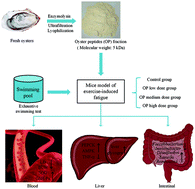Anti-fatigue property of the oyster polypeptide fraction and its effect on gut microbiota in mice†
Abstract
We aimed to evaluate the anti-fatigue effects of the oyster polypeptide (OP) fraction and its regulatory effect on the gut microbiota in mice. Our exhaustive swimming experiment showed that the swimming time of the low-, middle- and high-dose groups of the OP fraction was increased by 1.82, 2.18 and 2.44 times compared with the control group, respectively. Besides, the liver glycogen levels of the three groups were increased by 19.3%, 42.02% and 65.07%, while the lactate levels were decreased by 18.85%, 21.18% and 28.74%, respectively. Moreover, administration of the OP fraction upregulated the expressions of PEPCK and AMPK, but downregulated the TNF-α expression. Correlation analysis between the gut microbiota and fatigue-related biochemical indicators showed that Faecalibacterium, Desulfovibri and Intestinibacter were negatively correlated with the swimming time, blood lactate, blood urea nitrogen, liver glycogen and muscle glycogen, while Yaniella and Romboutsia were positively correlated. Therefore, the OP fraction had anti-fatigue effects, and could regulate the abundance of gut microbiota and maintain its balance.



 Please wait while we load your content...
Please wait while we load your content...